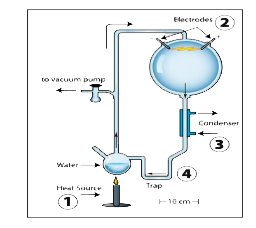In Miller’s experiment, He used a mixture of CH4 , NH3 , H2 and water vapour in a closed flask to mimic early earth’s conditions. What was the temperature at which this flask was kept?
800∘C
1200∘C
200∘C
400∘C
The correct Answer is:A
To solve the question regarding the temperature at which Miller's experiment was conducted, we can follow these steps:
Step 1: Understand the Context of Miller's Experiment
Miller's experiment, conducted by Stanley Miller and Harold Urey in 1953, aimed to simulate the conditions of early Earth to investigate the chemical origins of life. They used a mixture of gases that were believed to be present in the early atmosphere.
Hint: Familiarize yourself with the purpose and setup of Miller's experiment to understand its significance in the study of the origin of life.
Step 2: Identify the Gases Used
In the experiment, Miller used a mixture of methane (CH₄), ammonia (NH₃), hydrogen (H₂), and water vapor. These gases were chosen to replicate the reducing atmosphere of early Earth.
Hint: Remember the specific gases used in the experiment, as they are crucial for understanding the conditions simulated.
Step 3: Determine the Temperature
The experiment required a specific temperature to facilitate chemical reactions among the gases. According to the video transcript, the flask was heated to a temperature of 800 degrees Celsius.
Hint: Pay attention to the details provided in the context of the experiment, especially numerical values related to temperature.
Step 4: Evaluate the Options
The question provides four options: 800°C, 1200°C, 200°C, and 400°C. Based on the information from the experiment, we can conclude that the correct answer is 800°C.
Hint: Cross-reference the options with the information gathered from the experiment to identify the correct answer.
Final Answer
The temperature at which Miller's flask was kept during the experiment was 800 degrees Celsius.
---
Miller's experiment, conducted by Stanley Miller and Harold Urey in 1953, aimed to simulate the conditions of early Earth to investigate the chemical origins of life. They used a mixture of gases that were believed to be present in the early atmosphere.
In the experiment, Miller used a mixture of methane (CH₄), ammonia (NH₃), hydrogen (H₂), and water vapor. These gases were chosen to replicate the reducing atmosphere of early Earth.
The experiment required a specific temperature to facilitate chemical reactions among the gases. According to the video transcript, the flask was heated to a temperature of 800 degrees Celsius.
The question provides four options: 800°C, 1200°C, 200°C, and 400°C. Based on the information from the experiment, we can conclude that the correct answer is 800°C.
The temperature at which Miller's flask was kept during the experiment was 800 degrees Celsius.
Similar Questions
NH4OH,NaOH,CH3COOH,H2S
View SolutionConsider the molecules CH4,NH3 and H2O which of the given statement is false ?
View SolutionConsider the molecules CH4,NH3 and H2O which of the given statement is false ?
View SolutionConsider the molecules CH4,NH3 and H2O which of the given statement is false ?
View SolutionA flask of 4.48L capacity contains a mixture of N2 and H2 at 0∘C and 1atm pressure. If thed mixture is made to react to form NH3 gas at the same temperature, the pressure in the flask reduces to 0.75atm. Select statement(s) :
View Solution
(a) State the hypothesis which S.L. Miller tried to prove in the laboratory with the help of the set up given above.
(b) Name the organic compound observed by him in the liquid water at the end of his experiment.
(c) A scientist simulated a similar set up and added CH4,CH3 and water vapour at 800∘C Mention the important component that is missing in his experiment ?
View Solution1gH2,2g He and 3g NO are contained in 1.1 L flask at 300 K. Total pressure exerted by the mixture is :
View SolutionA student forgot to add the reaction mixture to the round bottomed open flask at 27∘C and put it on the flame After a lapse of time he realized his mistake using a pyrometer he found the temperature of the flask was 477∘C What fraction of air would have been expelled out ? .
View SolutionS.L. Miller an American scientist created electric discharge experiment in a closed flask containing CH4,H2,NH3 and water vapour at what temperature?
View SolutionFor the reaction
NH4HS(s)⇔NH3(g)+H2S(g)
in a closed flask, the equilibrium pressure is P atm. The standard free energy of the reaction would be:
View Solution
